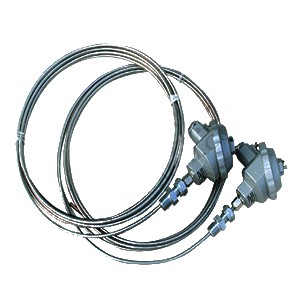Circular plug-in armored thermal resistance
The circular plug-in armored thermal resistance an
Description
The circular plug-in armored thermal resistance and thermal resistance both belong to the contact temperature measurement in the temperature measurement. Although their functions are the same to measure the temperature of the object, their principles and characteristics are different.
Thermocouple is widely used in temperature measurement. Its main characteristics are wide temperature range, stable performance, good dynamic response, simple structure, and more remote transmission of 4-20mA signal, which is convenient for automatic control and centralized control. The thermocouple principle of temperature measurement is based on thermoelectric effect. Two different conductors or semiconductors are connected into a closed loop. When the temperature at two junction points is different, the thermal potential is generated in the loop. This phenomenon is called thermoelectric effect, also known as Seebeck effect.The thermoelectric potential generated in the closed loop consists of two potential components: thermoelectric potential and contact potential. The temperature difference potential refers to the electric potential generated by different ends of the same conductor due to different temperatures. Different conductors have different electron densities, so they generate different potentials. The contact potential, as the name implies, means that when two different conductors are in contact, their electron density is different, resulting in a certain electron diffusion. The magnitude of electric potential and contact potential depends on the material properties of two different conductors and the temperature at which they contact. At present, the international thermocouple has a standard specification. The international thermocouple is divided into eight different divisions, namely B, R, S, K, N, E, J and T. The temperature of the thermocouple can be measured at 270 degrees below zero and up to 1800 degrees centigrade. B, R, and S belong to the thermocouple of platinum series. One is called cheap metal thermocouple.There are two types of thermocouples, common and armoured. Ordinary thermocouples are usually made up of heat electrodes, insulated tubes, protective sleeves and junction boxes. The armored thermocouple is a solid combination of three parts, namely, thermocouple wires, insulation materials and metal protective sleeves, which are assembled after stretching. However, the electrical signals of the thermocouple need a special conductor to transmit. This wire is called the compensation conductor. Different thermocouples need different compensation wires. Their main function is to connect the thermocouple, so that the reference end of the thermocouple is far away from the power supply, so that the temperature of the reference end is stable. The compensation conductor is also divided into two types, the compensation type and the extension type. The chemical composition of the extension wire is the same as that of the compensated thermocouple, but in practice, the elongated conductor is not made of the same material as the thermocouple, and the wire with the same electron density is usually used instead of the thermocouple. The connection between the compensating conductor and the thermocouple is usually very clear. The positive pole of the thermocouple connects the red line of the compensation conductor, and the negative pole is connected with the remaining color. Most of the material used in compensating wires is copper nickel alloy.
Thermal resistance is not only widely used in industrial temperature measurement, but also made into a standard reference instrument. However, because of the limitation of his temperature range, the principle of measuring thermal resistance is based on the change of resistance value of conductor or semiconductor along with the change of temperature. Its advantages are many, and it can also transmit electrical signals far away. It has high sensitivity, strong stability, good interchangeability and accuracy, but it needs power supply excitation and can not measure temperature changes instantaneously. The industrial thermal resistors usually use Pt100, Pt10, Cu50 and Cu100. The range of temperature measurement of platinum thermal resistance is generally 200-800 degrees below zero, and the copper thermal resistance is 40 to 140 degrees below zero. The thermal resistance is the same as the thermocouple, but he does not need to compensate for the wire and is cheaper than the thermocouple.
There are many installation forms of platinum thermal resistance, including fixed thread installation, movable thread installation, fixed flange installation, movable flange installation, movable pipe joint installation, straight pipe joint installation and so on.

Browse:


